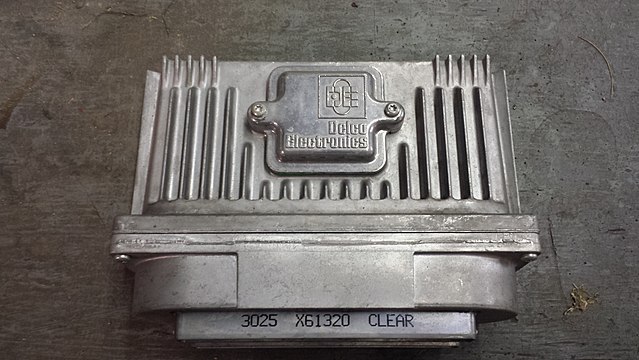Top Qs
Timeline
Chat
Perspective
Engine control unit
Computer that adjusts electronics in an internal combustion propulsion system From Wikipedia, the free encyclopedia
Remove ads
An engine control unit (ECU), also called an engine control module (ECM),[1] is a device that controls various subsystems of an internal combustion engine. Systems commonly controlled by an ECU include the fuel injection and ignition systems.

The earliest ECUs (used by aircraft engines in the late 1930s) were mechanical-hydraulic units; however, most 21st-century ECUs operate using digital electronics.
Remove ads
Functions
The main functions of the ECU are typically:
- Fuel injection system
- Ignition system
- Idle speed control (typically either via an idle air control valve or the electronic throttle system)
- Variable valve timing and/or variable valve lift systems
The sensors used by the ECU include:[2]
- accelerator pedal position sensor
- camshaft position sensor
- coolant temperature sensor
- crankshaft position sensor
- knock sensors
- inlet manifold pressure sensor (MAP sensor)
- intake air temperature
- intake air mass flow rate sensor (MAF sensor)
- oxygen (lambda) sensor
- throttle position sensor
- wheel speed sensor
Secondary
Other functions include:
- Launch control
- Fuel pressure regulator
- Rev limiter
- Wastegate control and anti-lag
- Theft prevention by blocking ignition, in response to input from an immobiliser
In a camless piston engine (an experimental design not currently used in any production vehicles), the ECU has continuous control of when each of the intake and exhaust valves are opened and by how much.[3][4]
Remove ads
Early systems
One of the earliest attempts to use such a unitised and automated device to manage multiple engine control functions simultaneously was created by BMW in 1939 Kommandogerät system used by the BMW 801 14-cylinder radial engine which powered the Focke-Wulf Fw 190 V5 fighter aircraft.[5] This device replaced the six controls used to initiate hard acceleration with one control, however the system could cause surging and stalling problems.[citation needed]
Remove ads
Use in motor vehicles
In the early 1970s, the Japanese electronics industry began producing integrated circuits and microcontrollers used for controlling engines.[6] The Ford EEC (Electronic Engine Control) system, which used the Toshiba TLCS-12 microprocessor, entered mass production in 1975.[7]
The first Bosch engine management system was the Motronic 1.0, which was introduced in the 1979 BMW 7 Series (E23)[8] This system was based on the existing Bosch Jetronic fuel injection system, to which control of the ignition system was added.[9]
In 1981, a Delco Electronics ECU was used by several Chevrolet and Buick engines to control their fuel system (a closed-loop carburetor) and ignition system.[10] By 1988, Delco Electronics was the leading producer of engine management systems, producing over 28,000 ECUs per day.[11]
Use in aircraft engines
Such systems are used for many internal combustion engines in other applications. In aeronautical applications, the systems are known as "FADECs" (Full Authority Digital Engine Controls). This kind of electronic control is less common in piston-engined light fixed-wing aircraft and helicopters than in automobiles. This is due to the common configuration of a carbureted engine with a magneto ignition system that does not require electrical power generated by an alternator to run, which is considered a safety advantage.[12]
Remove ads
See also
References
Wikiwand - on
Seamless Wikipedia browsing. On steroids.
Remove ads
